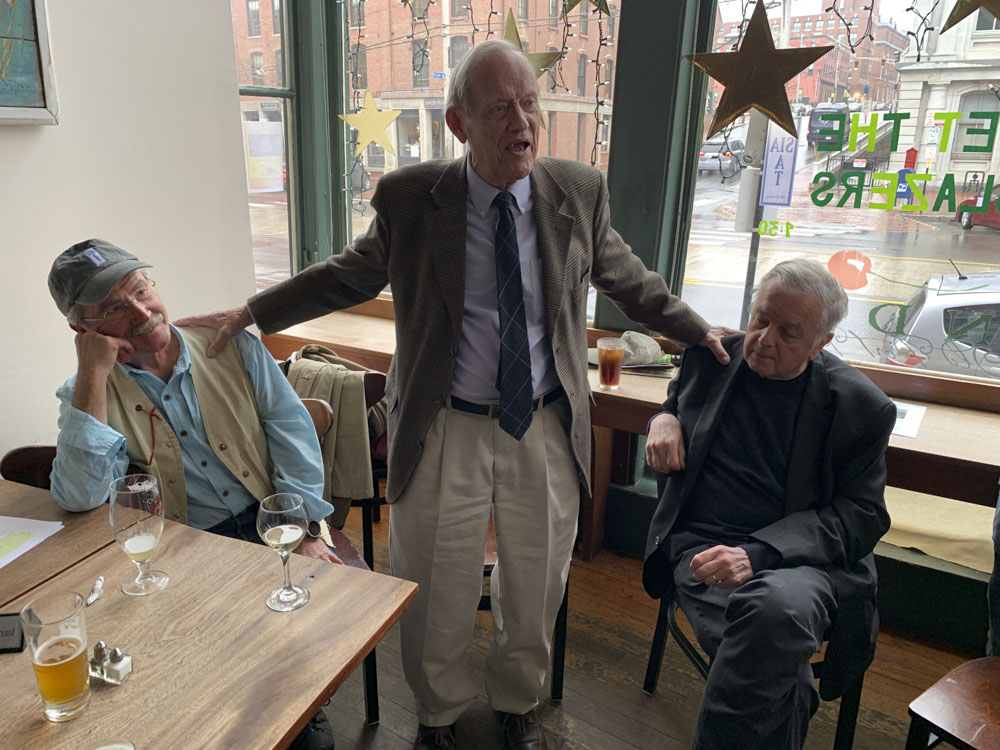2019 was a busy year for the Sendero Internacional de los Apalaches España.
Continue readingUlster Ireland Meeting at AMC in Boston
On November 13, IAT Co-Chairs Don Hudson of Maine and Paul Wylezol from Newfoundland joined Ulster Ireland mayors Michaela Boyle (Derry City and Strabane) and Nicholas Crossan (Donegal County) at a meeting with Appalachian Mountain Club President John Judge and Conservation and Recreation Director Heather Clish at their new headquarters in Boston, Massachusetts.
Continue readingComing to a smart phone near you!
For the past six months, the Maine Chapter of the IAT has been working with the developers of the premiere trail guide app, Guthook Guides, to create a digital hiker’s guide of the International Appalachian Trail in Maine and Canada.
Continue readingUlster Ireland Hosts Outdoor Economy Forum
From June 2 to 7, representatives of the International Appalachian Trail (IAT), Appalachian Trail Conservancy (ATC), Appalachian Mountain Club (AMC) and Appalachian Trail Museum gathered in Ulster Ireland for an Outdoor Economy Forum to discuss common issues and assist IAT Ulster Ireland develop a world-class trail network.
Continue reading10th Anniversary Visit to Scotland
From May 28 to June 2, representatives from IAT Newfoundland and Maine visited Scotland on a 10th anniversary IAT Europe tour which ended in Northern Ireland on June 7 after an Outdoor Economy Forum that also included representatives from the Appalachian Trail Conservancy and Museum, and Appalachian Mountain Club based in Boston, Mass.
Continue readingIAT 25th Anniversary Meeting at Shin Pond
On May 2-3, the International Appalachian Trail held a 25th Anniversary Meeting at Shin Pond Village in Northern Maine. The meeting was attended by IAT North America representatives from Maine, New Brunswick, Quebec and Newfoundland, as well as long-distance hikers Nimblewill Nomad (M.J. “Eb” Eberhart), Mother Nature’s Son (John Calhoun) and Ed Talone.
Continue readingThe IAT/SIA is 25!
Just a concept 25 years ago, the International Appalachian Trail now joins three continents!
Continue readingWalter Anderson Named Honorary Director
At the 24th annual IAT Maine meeting, President Don Hudson surprised long-time Board Member and IAT Chief Geologist Walter Anderson with a formal certificate recognizing him as an Honorary Director.
Continue readingFilm showcases journey through Katahdin Woods and Waters
On August 24th in 2016, an 87,563-acre plot of land in the heart of Maine was designated the Katahdin Woods and Waters National Monument by former President Barack Obama. Although met with controversy on all sides, the area had yet been explored on a large scale. In September 2017, a team of four Maine-born photographers set out on a three-part journey through Katahdin Woods and Waters to investigate.
Continue readingIAT Greenlanders Hikes IAT Newfoundland
From October 12 to 15, a small group of Greenland youth from the Uummannaq Peninsula and their Danish leader René Kristensen were in Western Newfoundland to hike sections of the IATNL. They were joined by French film maker Marc Buriot and arrived from St. John`s where they attended an Inuit Studies Conference and screened local Greenland films, including INUK.
Continue readingIAT Attends ALDHA’s 35th Annual Gathering
Highlighted by a blaze of fall colors, Board Members of the Maine Chapter of the International Appalachian Trail (MaineIAT) traveled along the Mohawk Trail (Rt.2) to Williams College, Williamstown, Mass. to attend the 3-day 35th Annual Gathering of the Appalachian Long Distance Hikers Association (ALDHA).
Continue readingIAT Presents at England’s Cook Museums
IAT Scotland’s Tom Stevenson Awarded BEM
Maine to Reroute 52 Miles of IAT
IAT Ulster-Ireland to Host Annual Meeting
UK Earth Heritage Magazine Features IAT
Pioneers of Appalachian/Caledonian Geology
IAT Crosses the Mediterranean into Africa
How Spain Discovered the “Apalchens”
Scotland’s Mull of Galloway Trail Hit By Storm
The creators of the Mull of Galloway Trail in southwest Scotland are shocked by the damage caused by a recent January storm. Members of the Stranraer Rotary Club walked the trail – which joined the IAT in May 2013 – to view the impact of the wind and high tides.
Continue reading












